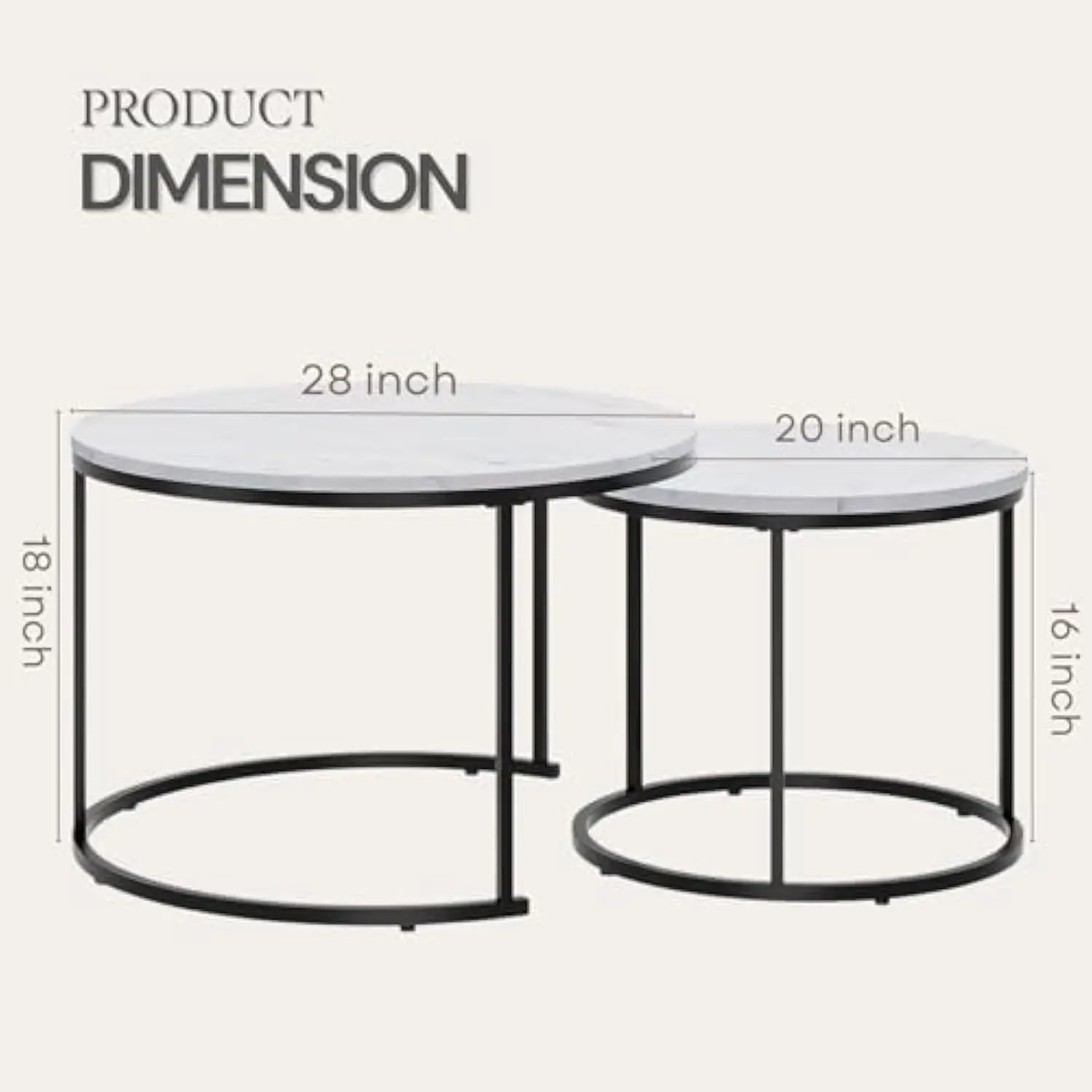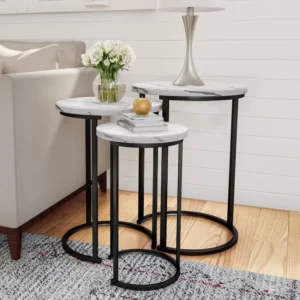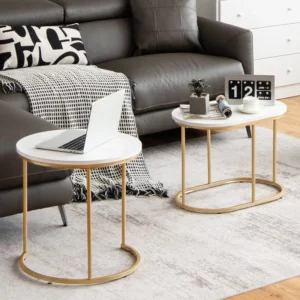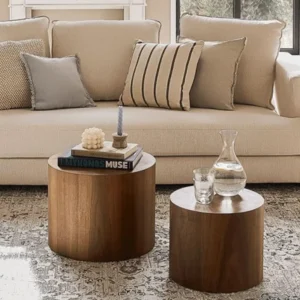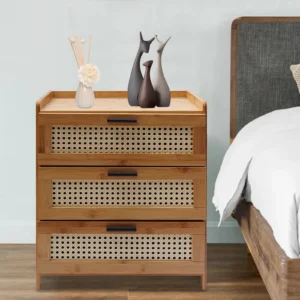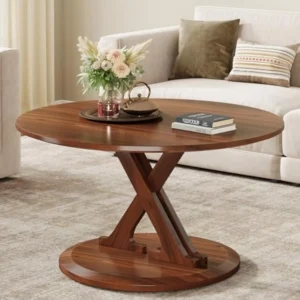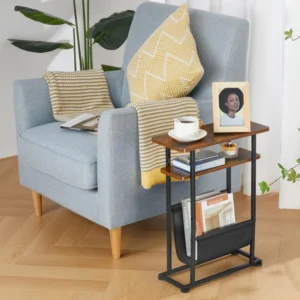Introduction: Transforming Limited Space with Strategic Furniture
Living in a small apartment presents unique challenges, particularly when trying to balance functionality with available square footage. As urban living spaces continue to shrink, finding furniture that maximizes utility without overwhelming limited floor space becomes essential. This is where nesting tables shine as a brilliant solution.
Nesting tables are sets of tables in graduating sizes designed to fit one beneath another, creating a compact footprint when not fully in use. Originally developed in the 18th century as “quartetto tables,” these space-saving marvels have evolved to become indispensable in modern compact living.
The beauty of nesting tables lies in their strategic design that addresses multiple needs at once. They offer remarkable space efficiency, unmatched versatility, aesthetic enhancement, and adaptability to changing circumstances. For anyone struggling with limited square footage, space-saving nesting coffee tables provide a smart alternative to traditional bulky furniture options.
In apartments where every inch counts, choosing the right furniture becomes crucial. Understanding the best shape coffee table for small space considerations can dramatically impact both the functionality and feel of your living area. Let’s explore why nesting tables have become the go-to solution for space-conscious apartment dwellers.
The Space-Saving Advantage: Maximizing Your Limited Square Footage
The primary benefit of nesting tables is their ability to dramatically reduce the footprint of your furniture when not in full use. Unlike conventional coffee tables that permanently occupy a fixed area, nesting tables can be compacted when additional surface area isn’t needed.
When nested together, a typical set of three tables might occupy just 12 x 16 inches (30 x 40 cm) of floor space, compared to a standard coffee table that commands 36 x 48 inches (91 x 122 cm). This represents an impressive 70-80% reduction in floor space utilization, a significant saving in apartments where every square inch matters.
The ingenious stacking function works through precisely calculated dimensions where each smaller table fits perfectly under the larger one. This vertical storage approach challenges the conventional horizontal space usage that traditional tables demand. When guests arrive or when you need additional surfaces, simply slide out the smaller tables. When alone or seeking more open floor space, nest them back together.
This space-saving design directly addresses the most pressing concern for small apartment dwellers: how to incorporate necessary furniture without feeling cramped. Maximizing small spaces with nesting coffee tables allows you to have multiple functional surfaces without the permanent floor space commitment.
For those seeking quality options, exploring our mid-century modern nesting coffee tables collection provides space-efficient solutions that don’t compromise on style or functionality.
Unmatched Versatility: One Furniture Set, Multiple Functions
Perhaps the most compelling advantage of nesting tables is their remarkable versatility. One set effectively replaces multiple pieces of furniture, serving different purposes throughout your day and adapting to your changing needs.
Morning Routine Enhancement
In the morning, use the largest table for breakfast or coffee while keeping smaller tables nested. The varied heights create perfect stations for different morning essentials – coffee on one level, reading materials on another.
Work-From-Home Solution
During work hours, pull out a smaller table to hold your laptop while the larger one maintains space for documents, notebooks, or a cup of coffee. The height differences create ergonomic advantages for different tasks.
Evening Entertainment Configuration
When entertaining, deploy all tables to create multiple surface areas for drinks, snacks, and games. Guests can have personal table space without the apartment feeling cluttered with furniture. This adaptability is particularly valuable when unlocking home entertaining with nesting tables.
Guest Accommodation
For overnight guests, the smaller tables make perfect bedside surfaces or can be arranged as makeshift dining spots when additional people are staying.
This multi-functionality eliminates the need (and expense) of purchasing separate side tables, coffee tables, and auxiliary surfaces. In a small apartment, this consolidation isn’t just convenient—it’s essential for maintaining a livable space.
The mid-century modern nesting table sets available today come in various configurations designed specifically to meet these diverse needs while maintaining cohesive style.
Enhancing Small Apartment Aesthetics: Style That Doesn’t Sacrifice Space
Beyond practical benefits, nesting tables offer significant aesthetic advantages for small apartments. Their tiered design creates visual interest through layered heights and dimensions, adding depth to rooms that might otherwise feel flat or cramped.
Different materials create distinct effects that can enhance small space perception:
Glass or acrylic tables: Create an illusion of spaciousness by maintaining visual flow and reflecting light. Their transparency prevents visual weight that might make a room feel smaller.
Wood tables: Add warmth and natural texture. Lighter woods like oak or maple keep spaces feeling airy, while darker woods like walnut provide sophisticated contrast.
Metal frames: Deliver sleek, modern appeal with minimal visual bulk. Their thin profiles maintain openness while providing structural strength.
Mixed material designs: Offer dimensional interest by combining elements like wood tops with metal legs, creating a custom look that can tie together other furniture pieces.
The design versatility of nesting tables means they complement numerous interior styles from mid-century modern to industrial, minimalist to eclectic. Their compact profile inherently contributes to an uncluttered aesthetic, which is essential in small spaces where visual clutter can quickly make rooms feel cramped.
For those drawn to classic designs with modern functionality, mastering mid-century nesting coffee tables can help create a cohesive look that maximizes both style and function. To explore complementary options, consider browsing our mid-century modern small coffee tables collection for space-conscious designs.
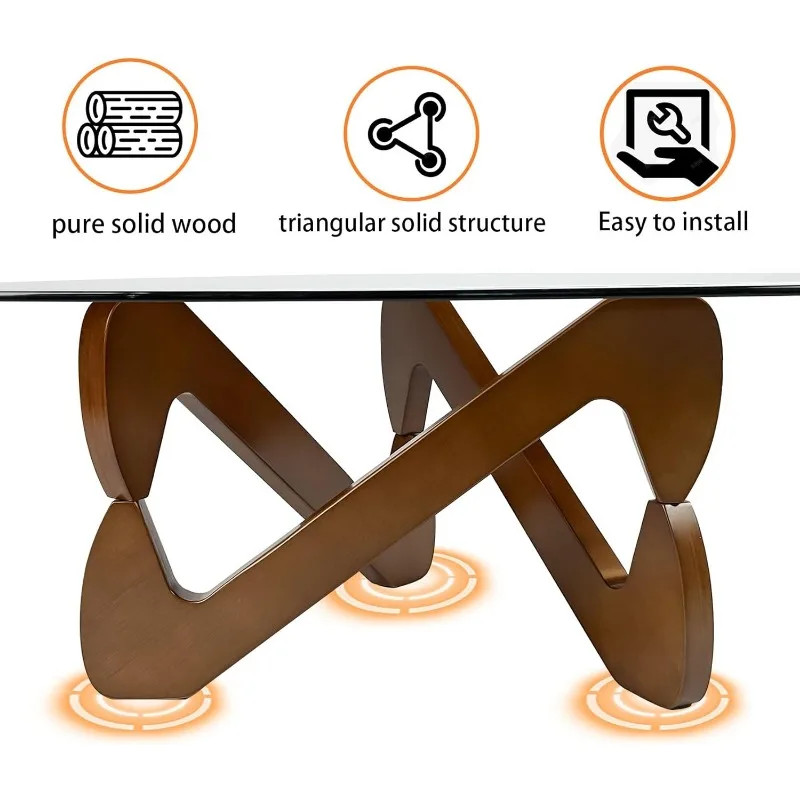
Adaptability to Changing Needs: Furniture That Evolves With Your Lifestyle
The dynamic nature of small apartment living requires furniture that can adapt quickly to changing activities and needs. Nesting tables excel precisely because they’re designed for transformation.
With most tables weighing just 10-15 pounds (4.5-6.8 kg) each, they can be effortlessly repositioned throughout your space. This lightweight nature makes them perfect for:
- Creating an impromptu dining area when meal delivery arrives
- Setting up a work surface near natural light during the day
- Moving to bedside for nighttime reading
- Arranging around a sofa for a game night with friends
Unlike bulky traditional furniture that dictates how you use your space, nesting tables allow your apartment to evolve based on your immediate needs. This adaptability proves invaluable as life circumstances change – whether you’re developing new hobbies, accommodating temporary work arrangements, or hosting overnight guests.
The surface area available can expand or contract based on current needs rather than permanently committing to a fixed footprint. This flexibility is particularly valuable in studio apartments where spaces must serve multiple functions throughout the day.
To complement your nesting tables with equally adaptable pieces, explore our selection of mid-century modern small side and end tables that work seamlessly together.
Strategic Selection: Choosing the Perfect Nesting Tables for Your Space
Finding the ideal nesting tables for your specific apartment requires consideration of several key factors:
Size Considerations
- Height relationship: Nesting tables should be 1-2 inches (2.5-5 cm) lower than your sofa arm height for comfortable reach and use
- Footprint dimensions: Measure your available space carefully, allowing for at least 18 inches (46 cm) between table edge and seating for comfortable leg room
- Proportionality: Tables should be proportionate to your seating – oversized tables in tiny spaces create awkward traffic flow
Material Selection
- Light-challenged spaces: Choose reflective materials like glass or light-colored surfaces
- High-traffic areas: Opt for durable materials that resist scratching and staining
- Existing décor: Select materials that complement rather than compete with existing furniture
Shape Considerations
- Round tables: Better for tight spaces and high-traffic areas as they eliminate sharp corners
- Square/rectangular tables: Provide more usable surface area and often nest more compactly
- Organic shapes: Can add visual interest but verify nesting function isn’t compromised
Quantity Factors
- Two-table sets: Perfect for very small spaces or minimal needs
- Three-table sets: The most versatile option for most apartments
- Larger sets: Consider only if you have specific needs for multiple surfaces
Weight Capacity
- Glass tops: Typically support 20-25 pounds (9-11 kg)
- Wood construction: Usually handles 30-40 pounds (14-18 kg)
- Consider typical use: Ensure tables can support your intended items (laptops, books, dining plates)
Understanding key features of space-efficient nesting tables will help you make an informed decision that maximizes both functionality and aesthetic appeal in your particular space.
Creative Placement Strategies: Optimizing Every Corner of Your Apartment
The placement of your nesting tables can dramatically impact both their functionality and your apartment’s flow. Consider these room-specific strategies:
Living Room Configurations
- Central arrangement: Place the largest table centrally with smaller ones partially visible for dimensional interest
- Flanking setup: Position the nested set beside a sofa or chair, pulling tables out when needed
- Corner utilization: Tuck the nested set in an underused corner, deploying tables when entertaining
Bedroom Integration
- Bedside solution: Use in place of traditional nightstands, expanding surfaces as needed
- End-of-bed placement: Position nested set at the foot of your bed for morning coffee or laptop use
- Dressing area: Create a flexible surface for accessories and personal items
Entryway Applications
- Mail station: Establish a dedicated spot for keys, mail and everyday essentials
- Display opportunity: Create a welcoming vignette that can expand when needed
- Transitional space: Provide a useful surface that doesn’t dominate a narrow entry
When planning placement, always maintain clear pathways of at least 24-30 inches (61-76 cm) for comfortable movement throughout your space. Avoid blocking natural traffic patterns or creating obstacles between frequently accessed areas.
For spaces with particularly tight clearances, round coffee tables often prove ideal as their curved edges allow for smoother navigation around furniture groupings.
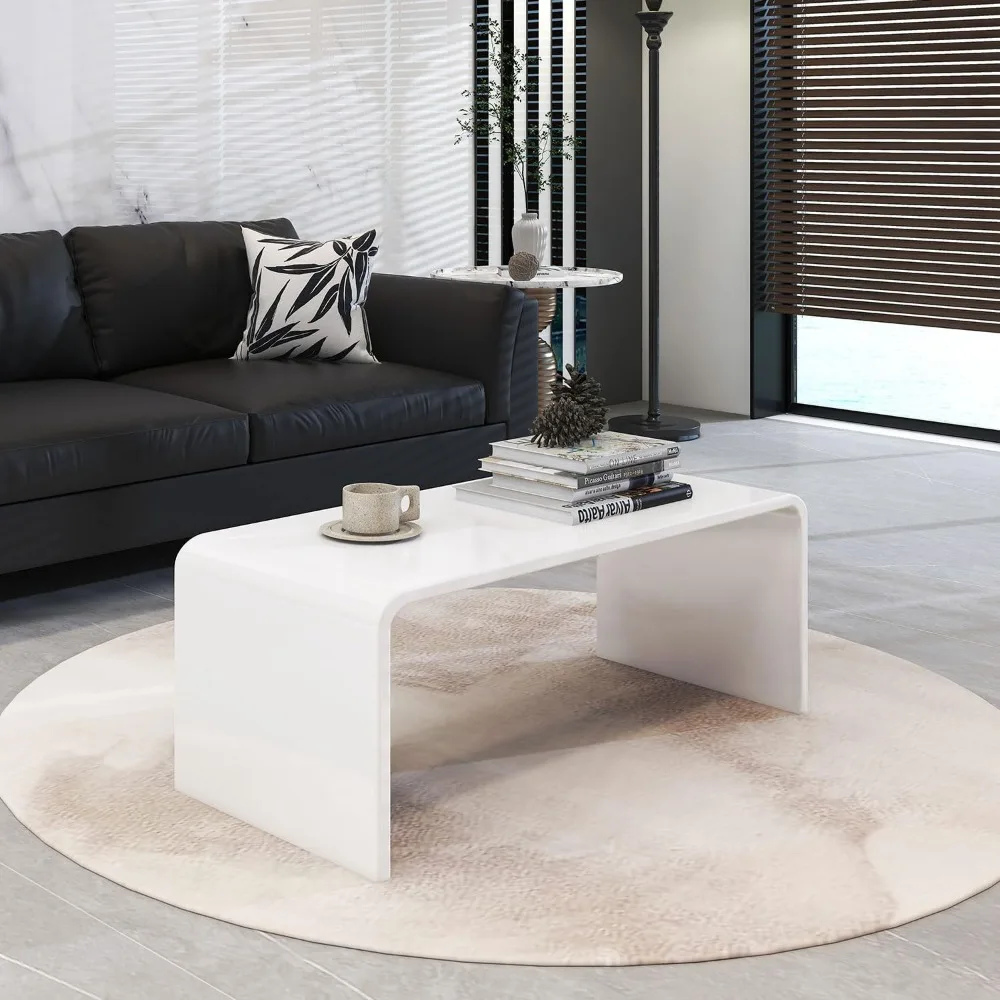
Styling Your Nesting Tables: From Functional to Fabulous
Styling your nesting tables elevates them from merely practical to visually striking elements in your apartment. The unique layered arrangement offers distinctive decorating opportunities:
Nested Arrangement Styling
When tables are nested together, create a cascading display by placing items of decreasing size on each level. This creates visual harmony while utilizing the various heights. For example:
– Largest table: Books or a substantial decorative object
– Middle table: Medium-sized plant or candle collection
– Smallest table: Small trinket box or miniature sculpture
Separated Table Styling
When tables are pulled apart, create a coordinated look through color cohesion while allowing each table to serve a distinct purpose:
– Maintain a common element (material, color, or texture) across all tables
– Vary the function of each table (one for drinks, one for reading materials, one for decorative items)
– Consider scale—decorative objects shouldn’t exceed 1.5 times the table height
Practical Styling Tips
- Use the rule of thirds when arranging objects for the most pleasing composition
- Incorporate both functional and purely decorative items for balance
- Rotate seasonal elements to keep your space feeling fresh
- Consider material-specific care (glass cleaner for glass tops, wood conditioner for natural surfaces)
For apartments where space is at an absolute premium, exploring small space coffee table alternatives can provide additional inspiration for styling and arrangement.
Mid-Century Modern Nesting Side & End Tables, Mid-Century Modern Nesting Table Sets, Mid-Century Modern Round Side & End Tables
Price range: $239.35 through $273.06 Select options This product has multiple variants. The options may be chosen on the product pageMid-Century Modern Nesting Coffee Tables, Mid-Century Modern Nesting Table Sets
$361.45 Select options This product has multiple variants. The options may be chosen on the product pageMid-Century Modern Nesting Table Sets, Mid-Century Modern Round Coffee Tables
$462.57 Select options This product has multiple variants. The options may be chosen on the product pageMid-Century Modern Small Side & End Tables, Mid-Century Modern Solid Wood Side & End Tables
$221.85 Select options This product has multiple variants. The options may be chosen on the product pageMid-Century Modern Round Coffee Tables, Mid-Century Modern Small Coffee Tables
$452.73 Select options This product has multiple variants. The options may be chosen on the product pageMid-Century Modern Small Side & End Tables
$95.00 Select options This product has multiple variants. The options may be chosen on the product page
Nesting Tables Versus Alternatives: Why They Often Win the Small Space Battle
When comparing furniture options for small apartments, nesting tables frequently outperform alternatives across multiple criteria:
Versus Traditional Coffee Tables
- Space Efficiency: Nesting tables use up to 75% less floor space when nested
- Versatility: Provide multiple surface options versus one fixed surface
- Adaptability: Can be reconfigured versus permanent placement
Versus Folding Tables
- Aesthetics: Typically more stylish and substantial-looking
- Convenience: No assembly/disassembly required
- Stability: Generally more stable and durable construction
Versus Wall-Mounted Options
- Flexibility: Can be moved as needed versus permanent installation
- Rental-friendly: No wall damage or modification required
- Multi-functionality: Can serve more purposes throughout the home
Versus Storage Ottomans
- Surface stability: Provide firm, level surfaces for drinks and delicate items
- Height variety: Offer multiple height options for different activities
- Visual lightness: Create less visual weight in small spaces
When evaluated by the metrics that matter most in small apartments—space efficiency, versatility, aesthetics, mobility, and cost-effectiveness—nesting tables consistently deliver exceptional value. They represent one purchase that serves multiple functions rather than requiring separate pieces for each need.
For a deeper dive into how these options compare, the article on nesting vs. folding coffee tables offers detailed analysis of their respective strengths.
Frequently Asked Questions About Nesting Tables for Small Apartments
What exactly qualifies as a “nesting table”?
Nesting tables are sets of two to four tables of graduating sizes specifically designed to fit one beneath another when not in use. They typically share a cohesive design but vary in dimensions to allow for compact storage.
How much weight can each table typically support?
Weight capacity varies by material and construction. Glass-topped nesting tables generally support 20-25 pounds (9-11 kg) per surface, while solid wood tables can often hold 30-40 pounds (14-18 kg) or more. Metal-frame tables with engineered wood tops typically fall somewhere in between.
Can nesting tables be used outdoors on small balconies?
Some materials work well outdoors, particularly metal frames with weather-resistant tops. However, most standard nesting tables are designed for indoor use. Look specifically for outdoor-rated options if balcony use is intended.
Are they suitable for households with children or pets?
Glass options may be less ideal for homes with small children or active pets. Wood or metal designs with rounded corners are generally safer choices. Consider weight and stability factors—heavier tables are less likely to tip if bumped.
What’s the price range for quality nesting tables?
Quality nesting tables typically range from $150-$600 depending on materials, construction quality, and design complexity. Investment pieces with premium materials or designer pedigrees can cost more, while basic sets may be found for less.
How do you clean and maintain different materials?
– Glass: Use standard glass cleaner and soft cloths to avoid scratching
– Wood: Dust regularly and treat occasionally with appropriate wood conditioner
– Metal: Wipe with damp cloth and dry immediately to prevent water spots
– Mixed materials: Follow specific care instructions for each component
How to Incorporate Nesting Tables with Existing Furniture: Creating Cohesive Small Spaces
Integrating nesting tables with your existing furniture requires thoughtful consideration of spatial relationships and design harmony:
Sofa Compatibility
Position nesting tables with 8-12 inches (20-30 cm) of clearance from your sofa edge for comfortable reach. The largest table’s height should complement your seating—ideally 1-2 inches (2.5-5 cm) below your sofa arm for ergonomic use.
Creating Visual Flow
Rather than perfectly matching your existing furniture, look for complementary elements that create continuity. This might be similar wood tones, complementary metal finishes, or echoing design elements like tapered legs or rounded edges.
Color Coordination
Use color theory principles to integrate your tables:
– Match one element of your tables to existing furniture (leg color, top finish)
– Choose contrasting pieces that fall within the same color family
– Use tables as a bridge between different furniture colors in your space
Scale Relationships
Ensure your nesting tables maintain appropriate proportional relationships with surrounding furniture. The largest table should not overwhelm nearby seating, while the smallest should remain functionally useful rather than appearing doll-sized.
Functional Groupings
Create intuitive furniture groupings where nesting tables enhance functionality. For example, position a nested set where it can serve both a reading chair and sofa edge, maximizing its utility without disrupting traffic flow.
For inspiration on exceptional design combinations, exploring exceptional designs of nesting coffee tables can provide ideas for creating truly cohesive spaces that maintain both functionality and style.
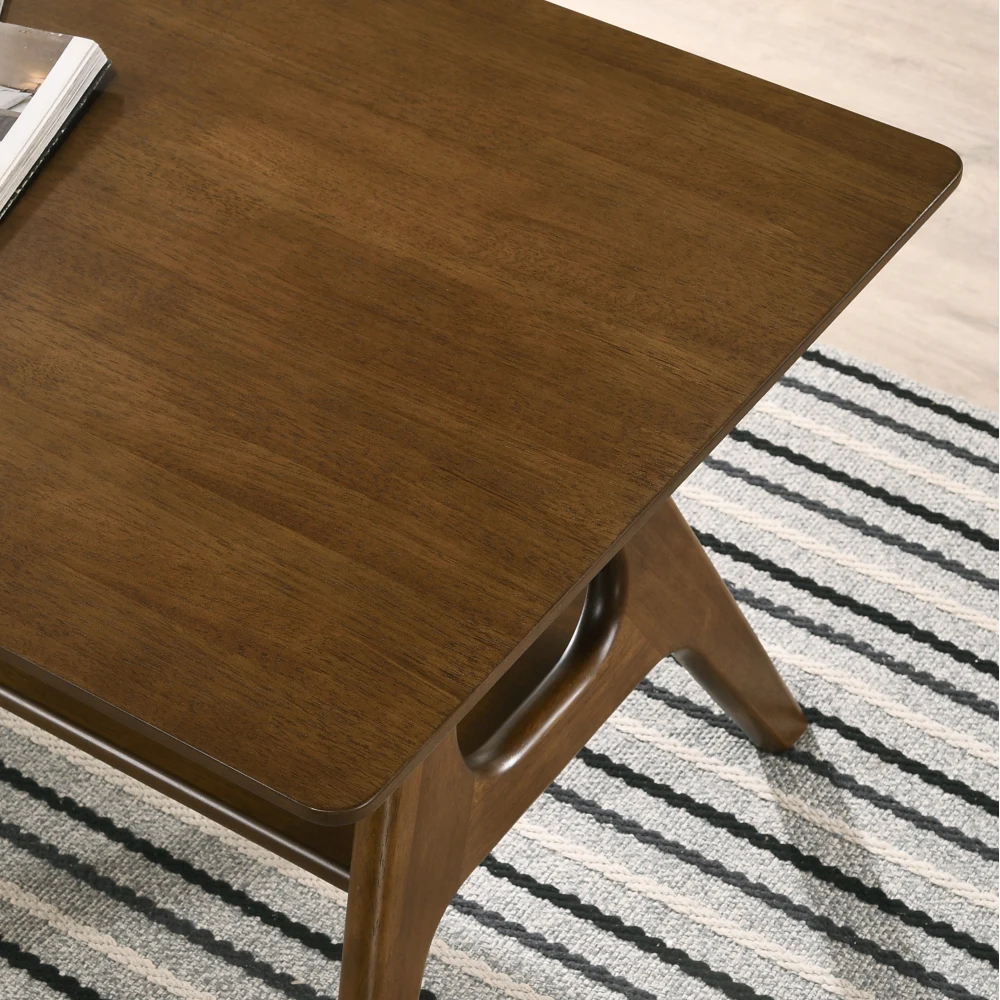
Nesting tables represent one of the smartest investments for small apartment living, offering unmatched versatility within a compact footprint. Their ability to transform from a single surface to multiple platforms addresses the constantly shifting needs of modern apartment dwellers. By carefully selecting tables that complement your space and existing furnishings, you create a more functional, adaptable, and visually appealing environment—proving that limited square footage doesn’t have to mean limited style or functionality.

